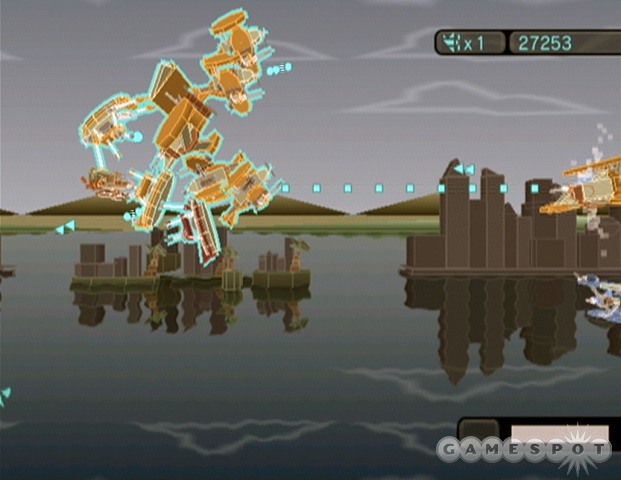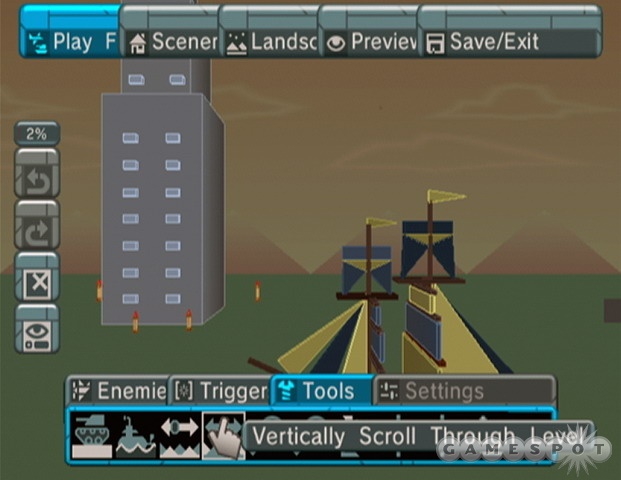Blast Works: Build, Trade, Destroy Hands-On
Build, fuse, and destroy: We do it all in our look at this unique Wii scrolling shooter.
Now, here's something completely different. Or more to the point, Blast Works: Build, Trade, Destroy for the Nintendo Wii isn't exactly a completely new idea as much as it is an extremely compelling mash-up of already familiar game ideas distilled into something that's very much a unique beast on the Wii. With elements of side-scrolling shooters, Katamari Damacy-type item collection, and extensive creation tools that are reminiscent of LittleBigPlanet, Blast Works just might be one of the most compelling under-the-radar games coming this year for the Nintendo Wii.

The heart of Blast Works is the scrolling shooter game; one that isn't much to look at upon first glance. What's up with the weird blocky environments, the blippy soundtrack, and the bullets coming off your ship that look like little squares? Yes, Blast Works' graphics have a distinctly Lego-like feel to them, but as you'll discover a bit later, that's by design. Still, roughly 10 seconds into the first level of Blast Works, you'll discover why this game is so special and so very odd. You see, any enemy weapon or ship you shoot down while working your way through the level can be added to your ship simply by flying next to it and letting it attach to your craft. In fact, larger ships often break apart into multiple smaller components, all of which can be attached to your base ship. With some skillful flying and collecting, your basic puny ship can quickly grow into a multilimbed monstrosity that takes up a quarter or more of the screen.
The sheer size of your ever-evolving ship is one thing; another cool aspect of this gameplay feature is that any piece of an enemy ship that you collect will be fully functional when it attaches to your ship. For instance, if you knock off a cannonball-blasting gun from an enemy craft, then manage to attach it so that the gun fires straight up on your ship, you'll be blasting cannonballs vertically until that piece is knocked off of your ship. Indeed, as your ship grows, so too can its firepower; it's not unusual to have a huge ship firing all sorts of different weapons from multiple angles. An additional side effect is that all of these pieces act as handy armor for your "core" ship. Expect to be constantly losing and collecting pieces of your evolving ship as you pilot your craft through the sometimes incredibly dense fire patterns that crop up in the latter sections of levels.
Control in Blast Works is simple; when using the Wii Remote by itself, you hold the controller horizontally, move your ship with the D pad, and fire your main weapon by holding down the 1 button. When using the Nunchuck, the analog stick moves your ship, and the B button fires. An essential feature is the ability to contract all of your "extra" attached parts by pressing the 2 button on the Wii Remote (or the Z button when using hte Nunchuck). While it's held down, all of your attachments will disappear, allowing you to skirt through tight areas without losing your firepower. Once you let go of the 2 button, your "full" ship will once again expand out, with all of its guns blazing. One good tactic is to keep your ship contracted just before facing an end-level boss because you'll need that additional firepower (not to mention the extra armor) for dealing with the boss's sometimes overpowering weaponry.
Now, remember that distinctly Lego vibe we mentioned regarding the game's graphics? There's a reason for it; namely the game's powerful creation tools that will let you create ships, buildings, weapons, and even entire levels from scratch in the game. Like Lego blocks, you'll piece together these different elements with basic shapes found in the game's building toolset. The tools seem almost too simplistic at first, but with some imagination, you begin to see exactly how you can create the same kind of complex vehicles and backgrounds that will be packed in with the game upon release--or at least sloppy-looking approximations, in our case.
For example, the ship builder will let you view your ship from a ton of different angles, and you can add new pieces, such as wings or weapons, simply by adding shapes on your ship. The basic shapes can be combined to create even more complex constructs, and there are a few moving shapes you can add to give your ship a bit more life. As with any good construction kit, you'll have full control over the size, shape, and color of any object you create. This ranges from your main ship to buildings you create for your levels and even enemy craft.
As with the object builders in Blast Works, the level designer (the same tool the game's developers used to create the built-in levels that come with the game) also appears deceptively simple at first, but within those basic tools are some powerful capabilities. With just a few button presses, you can set the basics, such as color scheme or background, then you can drag and drop enemies into your level either from either a list of prebuilt enemies or custom ships you've created along the way. There are also trigger events that can do things like change the orientation of your ship, the behavior of enemy ships, or the movement of the game camera. Finally there are an array of special effects you can add to your level (we were especially fond of the Virtua Boy-like effect, which turned everything in the level into red and black), as well as the ability to instantly preview your level to play test it to perfection.

If there's a downside to the creation tools in Blast Works, it's that the Wii Remote can sometimes be frustrating to work with, especially when dealing with the finer motions needed to accurately resize a certain part of your ship or building. But that really is just nitpicking on a system that looks to be only limited by the imagination of the player. If your imagination is as limited as ours (check the screens of our creations for proof), you can always download levels and items uploaded by other Blast Works players then play them to your hearts content or share your own creations with the world.
There's still more work to be done with Blast Works. For one, the sound effects aren't completely finished--the game is currently using synthesized trumpet sounds in place of explosions (though the more we played the game, the more we were convinced that the dissonant horn blasts were actually perfect for the game's off-kilter style). As the developers put the finishing touches on the game, we look forward to experimenting with our preview version to see what we can come up with. Blast Works' compelling combination of old-school graphics and gameplay with new-school imagination and technology makes it a game that will likely appeal to hardcore shooter fans and basement tinkerers alike. It's certainly one of the most interesting games coming for the Wii, and we look forward to its release in early May.
Got a news tip or want to contact us directly? Email news@gamespot.com
Join the conversation